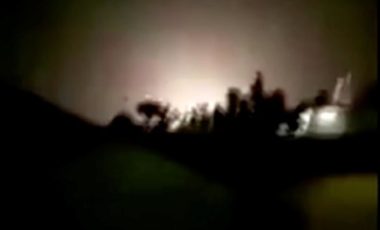Iran fires missiles at Iraqi bases in retaliation for US strike on commander

REUTERS
BAGHDAD/WASHINGTON: Iran said it launched a missile attack on US-led forces in Iraq in the early hours of Wednesday in retaliation for the US drone strike on an Iranian commander whose killing has raised fears of a wider war in the Middle East.
Tehran fired more than a dozen ballistic missiles from Iranian territory against at least two Iraqi military bases hosting US-led coalition personnel at about 1:30 am local time, the US military said on Tuesday.
Iran‘s Islamic Revolutionary Guards Corps confirmed that they fired the rockets to retaliate for last week’s killing of Qassem Soleimani, according to a statement on state TV.
The statement advised the United States to withdraw its troops from the region to prevent more deaths, state TV said.
What is said to be missiles are seen in the night sky, after Iran fired missiles on at least two Iraqi air bases hosting US-led coalition forces, in this still image taken from a video shot at an unknown location on January 8, 2020. Iran Press/Handout via Reuters
The Pentagon did not provide reports of casualties in the attack.
“We are working on initial battle damage assessments,” Pentagon spokesman Jonathan Hoffman said in a statement, adding that the bases targeted were al-Asad air base and another in Erbil, Iraq.
“As we evaluate the situation and our response, we will take all necessary measures to protect and defend US personnel, partners, and allies in the region.”
US President Donald Trump, who visited the al-Asad air base in December 2018, has been briefed on reports of the attack and was monitoring the situation, White House spokeswoman Stephanie Grisham said.

An explosion is seen following missiles landing at what is believed to be Ain al-Asad Air Base in Iraq, in this still image taken from a video shot on January 8, 2020. Iran Press/Handout via Reuters
“We are aware of the reports of attacks on US facilities in Iraq. The president has been briefed and is monitoring the situation closely and consulting with his national security team,” Grisham said in a statement.
US Secretary of State Mike Pompeo and US Defense Secretary Mark Esper arrived at the White House following news of the attack. It was unclear what response, if any, the United States was planning.
Hours earlier on Tuesday, Esper said the United States should anticipate retaliation from Iran over Friday’s killing in Iraq of Soleimani, commander of the elite Quds Force.
“I think we should expect that they will retaliate in some way, shape or form,” he told a news briefing at the Pentagon, adding that such retaliation could be through Iran-backed proxy groups outside of Iran or “by their own hand.”
“We’re prepared for any contingency. And then we will respond appropriately to whatever they do.”
Stock markets in Asia fell sharply on news of the rocket attack, while investor safe havens including the Japanese yen and gold shot higher.
Soleimani, a pivotal figure in orchestrating Iran‘s long-standing campaign to drive US forces out of Iraq, was also responsible for building up Tehran’s network of proxy armies across the Middle East.
He was a national hero to many Iranians, whether supporters of the clerical leadership or not, but viewed as a dangerous villain by Western governments opposed to Iran‘s arc of influence running across the Levant and into the Gulf region.
‘WE WILL TAKE REVENGE’
A senior Iranian official said on Tuesday that Tehran was considering several scenarios to avenge Soleimani’s death. Other senior figures have said the Islamic Republic would match the scale of the killing when it responds, but that it would choose the time and place.
“We will take revenge, a hard and definitive revenge,” the head of Iran‘s Revolutionary Guards, General Hossein Salami, told throngs who crowded the streets for Soleimani’s funeral on Tuesday in Kerman, his hometown in southeastern Iran.
Soleimani’s burial went ahead after several hours of delay following a stampede that killed at least 56 people and injured more than 210, according an emergency official quoted by Iran‘s semi-official Fars news agency.
Soleimani’s body had been taken to holy Shi’ite Muslim cities in Iraq and Iran, as well as the Iranian capital, Tehran, before arriving to be buried in the city cemetery’s “martyrs section”, according to the semi-official news agency ISNA.
In each place, huge numbers of people filled thoroughfares, chanting: “Death to America” and weeping with emotion. Supreme Leader Ayatollah Ali Khamenei wept as he led prayers in Tehran.
Prompted by the strong public backlash over Soleimani’s killing on Iraqi soil, lawmakers in Iraq voted on Sunday to demand a removal of all foreign forces from the country.
More than 5,000 US troops remain in Iraq along with other foreign forces as part of a coalition that has trained and backed up Iraqi security forces against the threat of Islamic State militants.
A NATO official told Reuters it would move some of its several hundred trainers out of Iraq. Canada said on Tuesday some of its 500 Iraq-based forces would be temporarily moved to Kuwait for safety reasons.
French President Emmanuel Macron, in a phone call on Tuesday to Iran‘s president, Hassan Rouhani, urged Tehran to avoid any actions that could worsen regional tensions.
US officials have said Soleimani was killed because of solid intelligence indicating forces under his command planned attacks on US targets in the region, although they have provided no evidence.
Ali Shamkhani, secretary of Iran‘s Supreme National Security Council, said 13 “revenge scenarios” were being considered, Fars news agency reported. Even the weakest option would prove “a historic nightmare for the Americans”, he said.